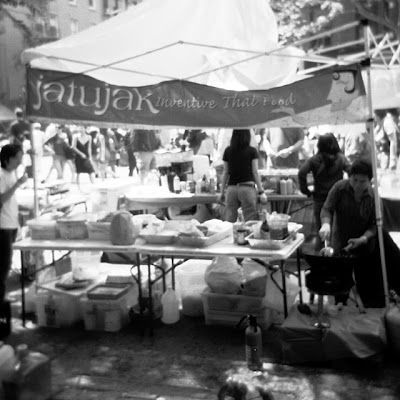
Louis Maldonado turned the Three Walls gallery into a ramshackle “traveling shanty-bazaar” designed to incubate social interaction hinging on the objects – things – Maldonado has created and identified as art – though the installation has little to do with the objects themselves. The space is designed around the procedures associated with acquisition. The context and limited functionality of the cramped plywood-partitioned space emphasizes conceptual rather than practical applications. There’s a warmly-lit viewing room (a closet, really) to facilitate the contemplation of potential art acquisitions, a lounge space lined with folding chairs, and a department dedicated to packaging and inventory. Though the space is crafted to support the consideration, discussion, and acquisition of the artwork, Moldonado’s collection of nondescript paintings and drawings are so unremarkable that any meaning or significance in the material object is removed, leaving a kind of negative space in which thing-centric social frameworks and interactions continue to exist – and come into the foreground. The aesthetics and presentation of the environment is at once earnest and self-consciously downscale, evoking a garage sale rather than an art gallery or auction house. The emphasis on barter rather than currency-based trade, an abandonment of the capitalist infrastructure traditionally surrounding the exchange of art, further reduced the significance of Moldonado’s objects – the works’ value and meaning was not instated at the time of production – instead, the act of bartering, and the establishment or understanding of some human attachment or history surrounding a particular work is intended to create value.
Instead of offering money for a piece of work, viewers/participants/barterers are supposed to propose an exchange of an equality uninteresting material object with some ostensibly interesting human story behind it. The process of exchanging stories is the focal point of the installation – and all who visit are encouraged to participate. Moldonado offers a microphone to the barterer, and feigns skepticism regarding the value of his end of the deal in the proposed trade – the inevitable agreement on relative value is documented with a digital photograph showing the objects exchanged in the hands of the barterer. The objects he receives in exchange are treated with equal reverence – care is given to how and where they will be displayed, measures that turn the “thing” into a vessel for human memory, thought, and commentary – a similar role, it seems, to the traditional functions of art. This content is imbued not in the aesthetics of the objects involved, but instead resides in the memory of the exchange – an archival task that falls on social rather than aesthetic structures, and, in doing so, questions the necessity of the latter.
On the whole, this didn’t quite work for me. I visited the gallery on the last night it was open, and the actual practice of the concepts the environment emphasizes doesn’t quite translate into anything particularly remarkable or meaningful. Perhaps the visitors had lost energy during the final throes of Moldonado’s residency, or maybe the wine was running out, but the gallery-goers did not seem quite sure as to how they fit in to Moldonado’s space – how their presence and participation positioned them on the spectator-spectacle continuum. Those who directly participated did so with a certain theatrical tone – and Moldonado seemed somewhat disappointed when a bartering visitor passed up the microphone. The structure of It’s all about things encourages attempts to give voice to that which goes unsaid – that which is normally spoken for in dollars instead of words. Again, it’s an earnest and endearing notion, but I’m not convinced that the activity designed to recast the value of objects. Moldonado acknowledges and critiques the idea that in order for something to be accessible, meaningful, and ultimately worthwhile, it has to be acquired in some capacity – even if the material acquisition is meaningless, there’s still an undertone of possession and accumulation that isn’t present in a batch of Rirkrit’s Pad Thai. Beyond this divergence of content, the theatricality of the entire arrangement seemed insincere. Were we not attempting to abandon monetary structures of ownership and acquisition in favor of some kind of utopian social sincerity? Why didn’t Moldonado, or the participants, seem to take bartering particularly seriously? The installation functions as satire to a certain extent, but in a way the satire never really gave way to revelation or sincere reconsideration of the structure and exchange of “things” in art and life. Moldonado references Heidegger’s semantic exchange of the term “work of art” for the word “things” as a means of defusing the problems of the former. However, in a way, Moldonado is asking us to traverse Heidegger’s semantic shift in reverse, and ascribe the vacuum left in the absence of conventionally valued things – and the material substitutes and social interactions proposed in It’s All About Things – back to the domain of art. Moldonado’s traverse from “art” to “things” is executed with such irony and exertion, that I’m left thinking that perhaps it’s not all about art or things, but about theatrics.









